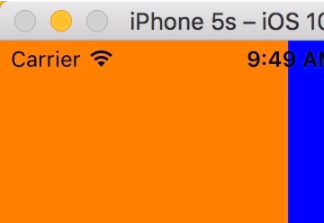我知道没人会主动设置这个东西,但是大家一定都遇到过这个问题,下面总结下可能是哪些情况:
1, self.automaticallyAdjustsScrollViewInsets = NO;
这个应该是最常见而且不容易被发现的原因,起因是iOS7在Conttoller中新增了automaticallyAdjustsScrollViewInsets这个属性,当设置为YES时(默认YES),如果视图里面存在唯一一个UIScrollView或其子类View,那么它会自动设置相应的内边距,这样可以让scroll占据整个视图,又不会让导航栏遮盖。
PS:iOS7里面的布局问题挺多的,使用autolayout的时候会遇到好多,大概是因为iOS7新加入autolayout还还不成熟导致的吧。
2,navigationbar设置问题
虽然表面上看是tableview顶部有空白,但实际上可能是因为navigationbar设置问题导致。
self.navigationController.navigationBar.translucent = NO; 这个属性设为no之后,tableview会在上方留出64.f的位置给navigationbar,也有小概率导致这个问题。
3,tableview section header高度设置问题
这个应该是新手遇到的比较多的。起因是iOS奇葩的逻辑,如果你设置header(或者footer)高度是0的话,系统会认为你没设置,然后将其设置为40.f。所以需要将其设置为一个较小的数:
|
1
2
3
|
- (CGFloat)tableView:(UITableView *)tableView heightForHeaderInSection:(NSInteger)section {return 0.001f;} |
4,tableview的header、footer设置问题
和3很像是不是?没发现区别吗?那就再读一次看看。这次是tableview的header视图引起的,而不是section的header高度引起。
对于tableview,不仅每个section有header,tableview整体也有header和footer,API如下:
|
1
2
|
@property (nonatomic, strong, nullable) UIView *tableHeaderView; // accessory view for above row content. default is nil. not to be confused with section header@property (nonatomic, strong, nullable) UIView *tableFooterView; // accessory view below content. default is nil. not to be confused with section footer |
这个header和footer要比section的header要和谐一些,只要你不去主动碰它就没事,但是如果你碰了...哼,哼...基本上会被设置出40.f高的间距。出现如下任意一行代码均会引起这个问题:
|
1
2
3
4
5
6
|
self.tableView.tableHeaderView = nil; self.tableView.tableHeaderView = [[UIView alloc] init]; self.tableView.tableHeaderView = [[UIView alloc] initWithFrame:CGRectZero]; self.tableView.tableFooterView = nil; self.tableView.tableFooterView = [[UIView alloc] init]; self.tableView.tableFooterView = [[UIView alloc] initWithFrame:CGRectZero]; |
对,你没想错,footerView也不能设置,footer和header只要设置了任意一个都会使两个地方都出现空白。不要问我为什么...
当然,如果有的时候真的只需要其中一个view的话该怎么办呢?请如下设置:(似不似傻,自己建一个view呗,非得用着恶心的东西么...)
|
1
2
|
self.tableView.tableHeaderView = [[UIView alloc] initWithFrame:CGRectMake(0, 0, kScreenSize.width, 0.0001f)];self.tableView.tableFooterView = [[UIView alloc] initWithFrame:CGRectMake(0, 0, kScreenSize.width, 0.0001f)]; |
说白了,还是得设置成一个很小的高度,而不是0才行。
关于tableView顶部空白的总结基本就这些了,如果想屏蔽的话,建议把这些写在baseTableViewController里面,这样就不用每次都扣这些东西了。宏懒得粘了,都是常见的,大家应该都能看懂。navigationbar那个,因为这个东西一般不在这里设置,写在base里面不是一个好的做法。
|
1
2
3
4
5
6
7
8
9
10
11
12
13
14
15
16
17
18
19
20
21
22
23
24
25
26
27
28
29
30
31
32
33
34
35
36
37
38
39
40
41
42
43
44
45
46
47
48
49
50
51
52
53
54
55
56
57
58
59
60
61
|
//// HLNBaseTableViewController.m// HLN-IMDemo//// Created by heiline on 15/8/25.// Copyright (c) 2015年 baidu. All rights reserved.//#import "HLNBaseTableViewController.h"@interface HLNBaseTableViewController () @end@implementation HLNBaseTableViewController- (void)viewDidLoad {[super viewDidLoad];self.tableView = [[UITableView alloc] initWithFrame:(CGRect){CGPointZero, kScreenSize} style:_tableViewStyle];[self.view addSubview:self.tableView];self.tableView.tableHeaderView = [[UIView alloc] initWithFrame:CGRectMake(0, 0, kScreenSize.width, 0.0001f)];self.tableView.tableFooterView = [[UIView alloc] initWithFrame:CGRectMake(0, 0, kScreenSize.width, 0.0001f)];if (self.navigationController != nil) {self.tableView.height -= kNavBarH + kStatusBarH;}if (self.tabBarController != nil) {if (self.navigationController.childViewControllers.count == 1) {self.tableView.height -= kTabBarH;}}self.tableView.delegate = self;self.tableView.dataSource = self;self.automaticallyAdjustsScrollViewInsets = NO;}- (void)dealloc {self.tableView.dataSource = nil;self.tableView.delegate = nil;}#pragma mark Table View Data Source And delegate Methods-(NSInteger)numberOfSectionsInTableView:(UITableView *)tableView {return 0;}-(NSInteger)tableView:(UITableView *)tableView numberOfRowsInSection:(NSInteger)section {return 0;}-(UITableViewCell *)tableView:(UITableView *)tableView cellForRowAtIndexPath:(NSIndexPath *)indexPath {return [[UITableViewCell alloc] init];}-(void)tableView:(UITableView *)tableView didSelectRowAtIndexPath:(NSIndexPath *)indexPath {}- (UIView *)tableView:(UITableView *)tableView viewForFooterInSection:(NSInteger)section {return nil;}- (UIView *)tableView:(UITableView *)tableView viewForHeaderInSection:(NSInteger)section {return nil;}- (CGFloat)tableView:(UITableView *)tableView heightForHeaderInSection:(NSInteger)section {return 0.001f;}- (CGFloat)tableView:(UITableView *)tableView heightForRowAtIndexPath:(NSIndexPath *)indexPath {return 40.f;}-(CGFloat)tableView:(UITableView *)tableView heightForFooterInSection:(NSInteger)section {return 0.001f;}@end |
















